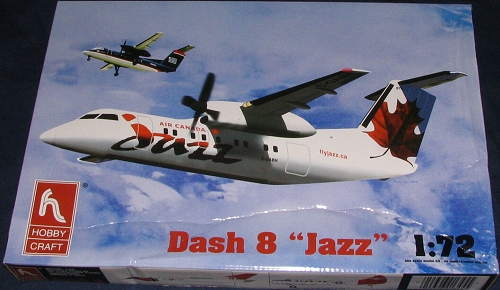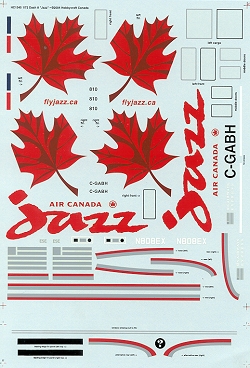
| KIT: | Hobbycraft 1/72 DHC-8 'Dash 8' |
| KIT #: | HC 1345 |
| PRICE: | $23.98 MSRP |
| DECALS: | Two options |
| REVIEWER: | Scott Van Aken |
| NOTES: |

| HISTORY |
Typical of Hobbycraft kits, the instructions are worthless when it comes to any sort of background info. It is like the subject just sorta happened to appear in the skies/land/sea. Perhaps it is part of cost savings......
Anyway, the DHC-8 is the most recent in a long line of successful deHavilland Canada civil aircraft that started with the DHC-1 Chipmunk. This time the Dash 8 is a feederliner that has been built in a variety of seating arrangements. It also continues the trend on not naming aircraft after Canadian woodland creatures that seemed to stop with the DHC-7. Too bad, as I thought it was a neat idea.
The Dash 8 is a very clean looking aircraft powered by twin turboprops and with the thin wing that seems to be so much in vogue with feeder-liners like the ATR 42, Dornier, and this one. Like most of DHC's aircraft, it can be and has been used by various military forces as short haul cargo aircraft.
| THE KIT |
 I have to tell you that I was
a bit surprised by how much space was left over in the box along with the
kit. Guess it is because it is a pretty basic kit. No cabin, for instance,
so one won't be spending a lot of time putting in seats. The cockpit is
pretty basic itself with seats, sticks, instrument panel and floor. There
is engraved detail on the instruments (a first for me). No decals are
supplied as alternates. No interior painting information either, though
there is mention of 15-20grammes of weight being needed. Now why do they
give a range? Is it like certain kits are lighter than others?
It should just say '20g' and leave it at
that. There seems to be enough room for it under the cockpit floor.
I have to tell you that I was
a bit surprised by how much space was left over in the box along with the
kit. Guess it is because it is a pretty basic kit. No cabin, for instance,
so one won't be spending a lot of time putting in seats. The cockpit is
pretty basic itself with seats, sticks, instrument panel and floor. There
is engraved detail on the instruments (a first for me). No decals are
supplied as alternates. No interior painting information either, though
there is mention of 15-20grammes of weight being needed. Now why do they
give a range? Is it like certain kits are lighter than others?
It should just say '20g' and leave it at
that. There seems to be enough room for it under the cockpit floor.

Transparencies are thick with sink areas in each of the cabin windows. However, you can see through them without too much trouble. I'd suggest painting the cabin matte black. Rather than being a single piece, the windscreen is two halves, which provides a nice seam in the clear bits to fill. Thanks HC. Wheel wells are all shallow with no detail. Hobbycraft provides individual prop blades with this one and tends to neglect mentioning how to assemble them in the instructions. OOPS!
Ah, the instructions. It is printed on both sides of an A4 sheet of paper. It is obvious that at one time it was on larger paper as you can barely read any of the warnings and advice, the printing is so small. More cost cutting, I'm sure. No markings information is provided in the sheet as it seems there are several boxings of the kit. Markings info is on the bottom of the box and you get two options. One is the overall white aircraft with the huge maple leaves for Jazz, which I have to guess is a subsidiary of Air Canada. The other is for a US Air feeder-liner with teeny markings, when compared to the flamboyant Canadian ones. Add to it the rather somber US Air color scheme and I can bet you most will go for the easy to paint Jazz scheme. Decals are very colorful, very well printed and look like they will work superbly. Later Hobbycraft kits (like this 2004 boxing) have outstanding decals, even if the kits themselves are a bit on the basic side.
| CONCLUSIONS |
When one considers this is an airliner, the lack of detail is really not such a bad thing. Face it, most airliner kits do not come with full interiors and are a bit basic. Whether that should carry over into 1/72 scale is something you need to think about. Regardless, the aircraft definitely looks cool and when done is undoubtedly going to be a real pleasing addition to the collection.
March 2005
Kit courtesy of me.
If you would like your product reviewed fairly and quickly by a site that has around 300,000 visitors a month, please contact me or see other details in the Note to Contributors.